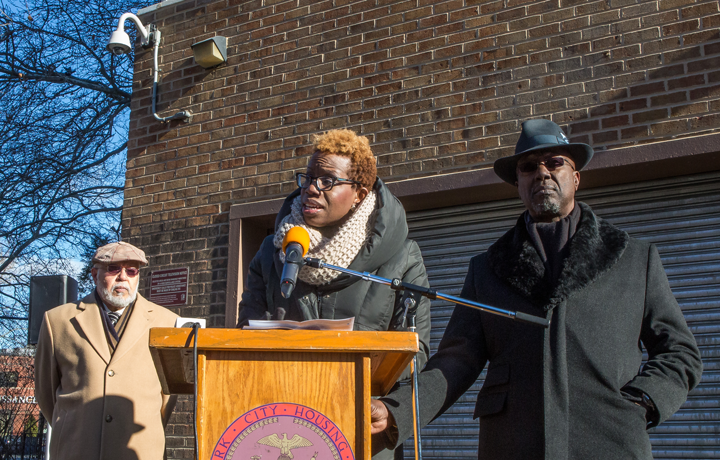
NYCHA
NYCHA chairwoman Shola Olatoye at a recent event.
It’s well known that the nation’s oldest and largest public-housing authority is strapped for operating money, burdened by a backlog of repair needs at its hundreds of aging buildings and in the midst of a plan called NextGeneration to try to reverse its financial crisis. Most attention, however, has been focused on the so-called “infill” plan to create mixed-income and 100 percent affordable housing at several NYCHA developments on land the administration considers underused.
But that’s just one part of what the kids are calling “NextGen.” Another is the use of an innovative mechanism called Rental Assistance Demonstration, or RAD. Late last week the authority launched the first RAD project in the city by issuing a request for proposals for developers to take on the RAD initiative at Ocean Bay (Bayside), a 24-building, 1400-apartment complex on the Rockaways.
As Batya Ungar-Sargon wrote in our November series on some of the tough choices facing NYCHA, under RAD, “Once converted from public housing to Section 8, NYCHA would sell the property to a consortium in which it and a private developer are partners, and then seek both federal tax credits and a mortgage.”
Ungar-Sargon described the debate over RAD:
[Bronx Councilmember Ritchie] Torres supports the program for the way it breaks NYCHA’s fatal reliance on federal funding. But changing public housing to Section 8 has other benefits too. “When people think public housing, it has a damaged brand: they think violence, social decay,” Torres explained. “Section 8 has a much better reputation.”
Couple that with the fact that Section 8 is a politically-protected source of funding, because it has a larger constituency: You have both Democrats and Republicans living in Section 8, which is used in both urban and rural settings, as opposed to Section 9, which you only find in big cities. And Section 8 is also a legally-protected form of funding because it’s a contract, rather than simply a budget item, like Section 9. The latter can be changed on a congressional whim. There are developers who rely on Section 8 funding, whose power can be used to protect NYCHA residents through RAD.
RAD is not without its risks. “The biggest risk is you are potentially bringing in an outside partner to work with the housing authority,” explained Holly Leicht, regional administrator of the U.S. Department of Housing and Urban Development (HUD). … There is also, however, the risk of foreclosure, which could happen if NYCHA defaults on any loans, though Leicht says that HUD would be able to intervene to help preclude an actual foreclosure.
Not everyone is convinced. In an article about RAD published in the Virginia Journal of Social Policy & the Law, Anne Marie Smetak, at the time practitioner in residence at Washington College of Law at American University, wrote that RAD’s use agreement requires only that the property remain affordable for tenants with incomes at or below 80 percent of area median income. “If a subsidy contract is terminated, the property will cease to be affordable to the lowest-income tenants, who are most in need of affordable housing,” she concluded. While the tenants would likely receive vouchers, the property would no longer be affordable in a meaningful way.
Smetak still supports RAD as a potentially important tool for cash-strapped housing authorities. But as City Limits reported in the fall, local housing advocates have their own concerns about RAD. “Our concern is long-term sustainability,” says James Rodruigez, from Good Old Lower East Side (GOLES). Under RAD, NYCHA and the city are no longer the only stakeholders. “Moving from conventional public housing to Section 8 puts a lot more onus on private owners to administer the program, with no assurance of permanence.”
It’s a plan for short-term funding at the expense of long-term sustainability, says Rodriguez. “Ten to 20 years in the future doesn’t give us the assurance that we need, with private developers getting more and more aggressive throughout the city,” he says.
You can read NYCHA’s RFP here and their press release about the move here.








One thought on “NYCHA Launches New Bid to Close Financial Gap”
Sick of reading about NYCHA. Vast majority of tenants receive taxpayer-paid electricity and water. Freeloaders.